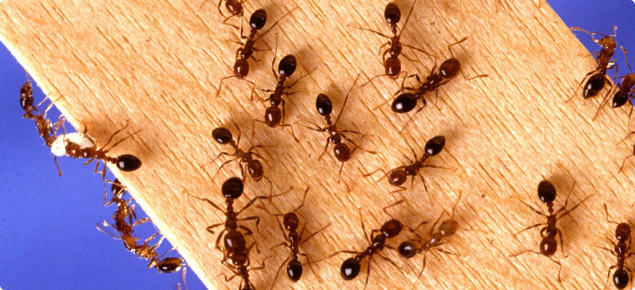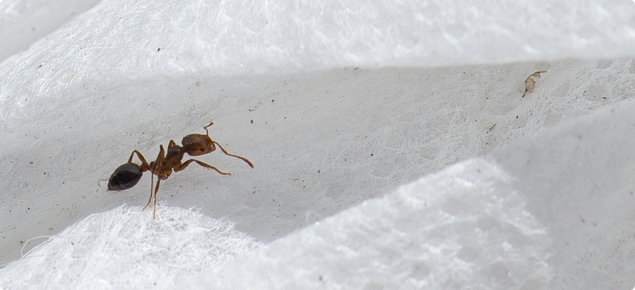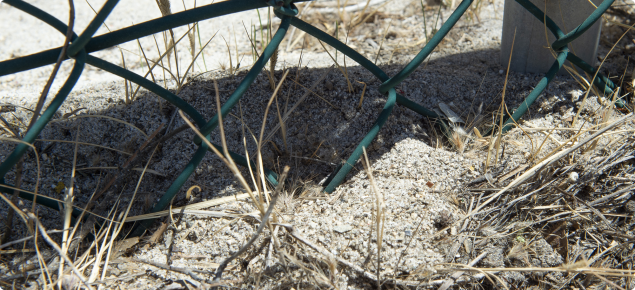If RIFA became established in WA, it could severely damage the local environment, economy and Australia's outdoor lifestyle. RIFA inflict a painful, fiery sting, which in rare cases can cause an acute allergic reaction.
Background
The invasive ant pest was first detected at the Fremantle Port in November 2019 as part of the surveillance being undertaken for the National Browsing Ant Eradication Program.
A 2-year comprehensive eradication and surveillance program was undertaken by the Department of Primary Industries and Regional Development. This included six rounds of visual surveillance involving hand collection, lures, pitfall traps, and the use of specifically trained odour detection dogs from Queensland.
As part of the eradication effort more than 3,500 premises, including container and ferry terminals, industrial properties, fishing wharves, parks and recreational spaces and residential properties were inspected multiple times, with over 14,000 samples collected for identification.
Support and co-operation from Fremantle Port and their tenants, the City of Fremantle, Town of East Fremantle, local residents and businesses during the surveillance, baiting and quarantine activities was crucial to the success of the response.
Western Australia was declared free of red imported fire ant on 21 October 2023.
It is important that any further detections of RIFA or any unusual animal or plant pests or diseases are reported immediately via the MyPestGuide Reporter app so that the pest can be contained and eradicated efficiently and effectively.
How to identify red imported fire ant
Images
What to look for
- Hard to distinguish from common native ants.
- 2-8mm, reddish brown in colour with a darker abdomen.
- Ants of varying sizes in one nest.
- Nests that often have no visible entry holes like other ant nests.
- Young nests can be indistinct or start out as small piles of excavated soil.
- A fiery sting that can blister and form pustules at the sting site.
An identification video (courtesy of the National Red Imported Fire Ant Eradication Program) may be useful if you are looking for nests or observing ants. Although please keep in mind any RIFA nests in WA will look different to nests in Queensland due to our sandy soils.
Where to look
RIFA nests may be found next to or under other objects on the ground, such as timber, logs, rocks, pavers or bricks. Look near pots or any areas of disturbed ground as well as:
- pot plants on the ground
- stores of topsoil, mulch and potting mixes
- open areas like lawns, firebreaks or fence lines.
- under landscape materials (e.g. logs, stones)
- under timber or pallets on the ground
- adjacent to buildings and other structures
- untidy or overgrown areas
- near areas of permanent water (e.g. the banks of dams, rivers, ponds, aquaculture containers)
- tufts of grass in open areas, where the soil is built up around the tufts.
Impact of RIFA
Health
- Can inflict a painful and fiery sting, which in some people can cause an allergic reaction.
- Fire ants usually move quickly, allowing large numbers to move onto humans before they are detected.
- Stings from fire ants can cause a painful, burning, itching sensation, lasting up to 1 hour.
- Multiple stings give sensation that body is on fire.
- Small pustules may form at sting sites several hours after stinging and may become itchy.
- Broken pustules may become infected.
Environmental
- Can eventually form 'super colonies' with multiple queens and can spread rapidly.
- Potential to inhabit most of Australia’s major coastal areas and extensive areas of tropical north.
- Feed voraciously on small ground fauna, including insects, spiders, lizards, frogs, birds and mammals. Could displace or eliminate some native species.
- Eat and damage seeds, possibly causing major ecosystem changes over time.
Economic
- Fire ant mounds can be serious problem in lawns, sporting fields and golf courses.
- Damage sensitive electrical equipment.
- Affect tourism industry and export of items to fire-ant-free countries.
- Significantly affect agriculture industry. More than 50 agricultural and horticultural crops, as well as turf and nursery species, are affected by fire ants. All are grown in Australia, in areas that fire ants could inhabit.
- Attack young animals, stinging around eyes, mouth and nose, leading to blindness and suffocation.
- Prevent animals from reaching food or water without being seriously stung, leading to starvation and dehydration.
- Can damage and kill some plants by tunnelling through roots and stems.
- Protect some pest insect species that produce 'honeydew', downgrading quality of produce and helping to spread disease.
- Feed on important biological control agents, interfering with integrated pest management practices.
- Mounds can destroy equipment, such as irrigation systems, and damage machinery during harvesting operations.
Social
- Restrict everyday activities such as picnics and sporting activities as backyards, parks, school playgrounds and sports grounds are unusable.
RIFA safety and first aid advice
Always safety first if you come across an ant nest. Don’t stand on the nest or disturb it as ants may aggressively defend it. Only take photos if safe to do so. You should take the following steps if stung:
- If the ants are still on you or your pet, pick them off by hand. If you try and brush them off this will make them more aggressive, and if ants are sprayed with water, they may latch on with their jaws.
- Apply a cold compress to alleviate swelling and pain.
- Carefully wash the affected area with soap and water.
- Immediately seek medical attention if you are allergic to insect stings or have symptoms of allergy.
Fire ant stings can take up to 10 days to heal. If the blisters or pustules break, there is a risk they can get infected. If pain persists or blisters get infected, see your doctor. Infected stings may require antibiotics.
Visit HealthyWA for more information.
Frequently Asked Questions
What is a red imported fire ant (RIFA)?
A red imported fire ant is a serious exotic pest that poses significant social, economic and environmental threats to Western Australia. It is native to South America and is known to be highly aggressive and invasive and can inflict painful stings on people, pets and livestock.
How did it get here?
Results from genetic testing indicate the ant detection at Fremantle Port in 2019 was most likely introduced from overseas and is not linked to the Queensland detections. It is possible they arrived on a shipping container or on earth moving machinery and equipment.
Where have they been found?
RIFA were detected during specific targeted surveillance by the Department of Primary Industries and Regional Development (DPIRD) on two adjoining properties at Fremantle Ports. The detection was localised to the initial detection site and an established red imported fire ant nest was found on the site.
Western Australia has completed a successful biosecurity eradication response with the National Biosecurity Management Group declaring the State free of RIFA in October 2023.
How do I tell if ants are red imported fire ant?
Red imported fire ants are small (2-8mm), reddish-brown in colour, with a darker abdomen. There can be many different sized ants in one nest. They are usually aggressive if disturbed and can inflict a painful, fiery sting. Fire ant nests often look like disturbed soil or a small mound of soil with no visible entry holes. Nests may be in open areas or under logs, rocks or garden materials.
Where should I look?
Look around any areas of disturbed ground, pot plants, top soil, mulch, under landscaping materials such as logs or stones, in any untidy or overgrown areas, or near areas of permanent water (eg. dams, rivers or ponds).
Why are they a problem?
Fire ants are one of the world's worst invasive ant species. They pose a serious threat to our lifestyle, environment, economy and agriculture, as they can form supercolonies that spread rapidly, feeding on insects, small ground fauna and crops. They also extremely aggressive and cause painful stings, which in some cases may cause anaphylactic allergic reactions. You can read more on their impacts here.
Can I treat an infestation myself?
No. Do not disturb a suspected red imported fire ant nest, as they are often highly aggressive and may swarm if disturbed. If you suspect red imported fire ant contact DPIRD IMMEDIATELY.
What should I do if I get stung?
Refer here for first aid advice. Apply ice to relieve the swelling and pain. Gently wash the area with soap and water and leave any blisters intact. People who experience an allergic reaction after an insect sting should seek medical attention immediately.
What do I do if I suspect red imported fire ant?
LOOK AND REPORT! Report any unfamiliar ants immediately – even if unsure.
Do not disturb ants as they may aggressively defend the nest. Do not send in live ants. Take a photo if safe to do so.
Contact the department via:
- MyPestGuide Reporter app
- MyPestGuide website
- DPIRD’s Pest and Disease Information Service +61 (0)8 9368 3080
- padis@dpird.wa.gov.au
What has been done to control RIFA in WA?
Following the incursion at Fremantle Port in 2019, Western Australia has completed a successful biosecurity eradication response with the National Biosecurity Management Group. Response activities included a two-year surveillance and treatment program to demonstrate successful eradication of the pest.
How do RIFA spread?
RIFA can spread naturally through flight, and by assisted spread such as movement of infested materials. Fire ant nests can have a single queen or multiple queens. A new queen will lay up to 20 eggs initially. Eggs hatch in 7-10 days and become adults after 9-15 days. A queen can increase laying capacity up to 800 eggs per day after the initial hatching.
What can I do to help prevent the spread of fire ants?
Report suspected red imported fire ant immediately.
Contact the department via:
- MyPestGuide Reporter app
- MyPestGuide website
- DPIRD’s Pest and Disease Information Service +61 (0)8 9368 3080
- padis@dpird.wa.gov.au







